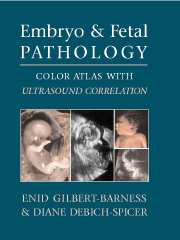Book contents
- Frontmatter
- Contents
- Foreword by John M. Opitz
- Preface
- Acknowledgments
- 1 The Human Embryo and Embryonic Growth Disorganization
- 2 Late Fetal Death, Stillbirth, and Neonatal Death
- 3 Fetal Autopsy
- 4 Ultrasound of Embryo and Fetus: General Principles
- 5 Abnormalities of Placenta
- 6 Chromosomal Abnormalities in the Embryo and Fetus
- 7 Terminology of Errors of Morphogenesis
- 8 Malformation Syndromes
- 9 Dysplasias
- 10 Disruptions and Amnion Rupture Sequence
- 11 Intrauterine Growth Retardation
- 12 Fetal Hydrops and Cystic Hygroma
- 13 Central Nervous System Defects
- 14 Craniofacial Defects
- 15 Skeletal Abnormalities
- 16 Cardiovascular System Defects
- 17 Respiratory System
- 18 Gastrointestinal Tract and Liver
- 19 Genito-Urinary System
- 20 Congenital Tumors
- 21 Fetal and Neonatal Skin Disorders
- 22 Intrauterine Infection
- 23 Multiple Gestations and Conjoined Twins
- 24 Metabolic Diseases
- Appendices
- Index
6 - Chromosomal Abnormalities in the Embryo and Fetus
Published online by Cambridge University Press: 23 February 2010
- Frontmatter
- Contents
- Foreword by John M. Opitz
- Preface
- Acknowledgments
- 1 The Human Embryo and Embryonic Growth Disorganization
- 2 Late Fetal Death, Stillbirth, and Neonatal Death
- 3 Fetal Autopsy
- 4 Ultrasound of Embryo and Fetus: General Principles
- 5 Abnormalities of Placenta
- 6 Chromosomal Abnormalities in the Embryo and Fetus
- 7 Terminology of Errors of Morphogenesis
- 8 Malformation Syndromes
- 9 Dysplasias
- 10 Disruptions and Amnion Rupture Sequence
- 11 Intrauterine Growth Retardation
- 12 Fetal Hydrops and Cystic Hygroma
- 13 Central Nervous System Defects
- 14 Craniofacial Defects
- 15 Skeletal Abnormalities
- 16 Cardiovascular System Defects
- 17 Respiratory System
- 18 Gastrointestinal Tract and Liver
- 19 Genito-Urinary System
- 20 Congenital Tumors
- 21 Fetal and Neonatal Skin Disorders
- 22 Intrauterine Infection
- 23 Multiple Gestations and Conjoined Twins
- 24 Metabolic Diseases
- Appendices
- Index
Summary
Structural chromosomal abnormalities include translocations, inversions, deletions, ring chromosomes, isochromosomes, intrachromosomal duplications, insertions, and dicentric chromosomes (Figures 6.1 and 6.2).
Inversions involve two breaks within a single chromosome with the intervening segment inverted.
Deletions are the result of a distal break or two internal breaks on the chromosome, allowing portions of chromosomal material to be lost. When two breaks occur, a ring chromosome can be formed.
Isochromosomes are usually mirror image chromosomes that result from single breaks close to the centromere, thus eliminating the whole of a long or short arm.
Chromosomeabnormalities represent the largest categoryof causes of deaths in humans (Table 6.1). Abortuses that have reached a 2-week stage of development are estimated to have a 38% rate of chromosome abnormalities. In liveborn infants, the rate of chromosome defects is 1:200.
In stillbirths (≥20 gestational weeks), the rate of chromosome abnormalities is between 6.6% and 11.7%. In fetuses between 9 and 20 weeks, the rate of chromosome abnormalities is around 7%. The average rate of chromosome defects of spontaneously aborted embryos earlier than 9 weeks is about 60% (59.1%) and above 60% in abortuses of a developmental age less than 7 weeks. It is conceivable to the rate of chromosome abnormalities before 2 weeks (i.e., between fertilization and the early previllous stages shortly after implantation) is 82%.
Fetuses with abnormal chromosomes are encountered after termination of Pregnancy for prenatal detection of a chromosome anomaly; after termination of pregnancy when major fetal anomaly or intrauterine fetal death has been diagnosed by ultrasound examination; and, less commonly, in a second trimester spontaneous abortus.
- Type
- Chapter
- Information
- Embryo and Fetal PathologyColor Atlas with Ultrasound Correlation, pp. 180 - 206Publisher: Cambridge University PressPrint publication year: 2004



